How to effectively and easily clean the iron from the burn
If during ironing things always maintained a temperature regime, then the question of how to clean the iron from the burn would simply not arise. Due to the accumulation of plaque, the sole of the device begins to slide poorly on the fabric, which leads to the deterioration of things and another burning. To avoid the appearance of yellow and brown spots on things will help knowledge of how to clean the iron from the burnt fabric.
Content
Ways to clean the iron from carbon
To keep the surface of the sole in perfect condition is easy if you carefully consider the recommendations for ironing things from natural and synthetic fibers. The safe temperature is indicated on the clothing label, the bedding package. But what if an accidental violation of the recommended temperature conditions caused the tissue to burn?
Cleaning the iron from the burn can be done as special chemicals purchased at the hardware store, and folk remedies. Many simple but effective recipes have been preserved since the times when the irons did not have thermostats. Before you clean the iron from the burnt fabric, you need to pay attention to the material from which the sole of the device is made.
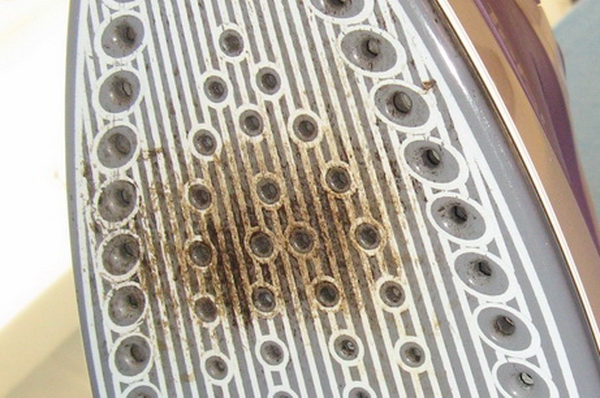
If ceramic iron needs to be cleaned, the use of abrasives and salt is contraindicated: any scratch can lead to the detachment of ceramics. Sole with Teflon non-stick coating can also be damaged by the solid particles contained in the detergent. Even the cheapest steel device can be rendered unusable if you try to remove contamination with an emery cloth, metal wool or brush. The surface, scratched by inept cleaning, begins to cling to the thin fibers of the fabrics, tears them off, and they are charring, forming the very carbon from which the hostess is trying to get rid of.
Gentle cleaning of ceramics and teflon
The most common tool is a cleaning pencil with acids or ammonia.You can purchase it at any hardware store or company where the iron was purchased. The device must be installed vertically and heated to + 130 ... + 200 ° C. To carry out a pencil on a sole without strong pressure. The tool begins to melt and removes burnt plaque.
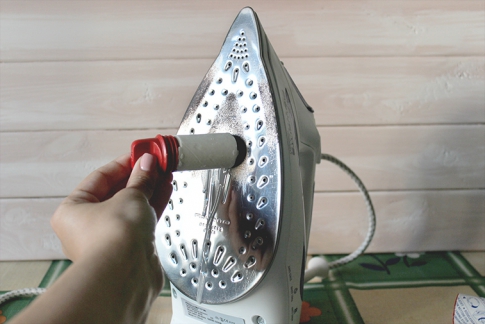
With this cleaning method, it is important to ensure that the molten substance does not fall into the steam holes, as this may cause them to clog and cause damage to the device. After processing on the iron there is a trace from the pencil, which is easily removed when ironing a clean cloth (rags, rags). Inhalation of vapors during cleaning may be harmful to persons with increased sensitivity to odors and bronchial diseases.
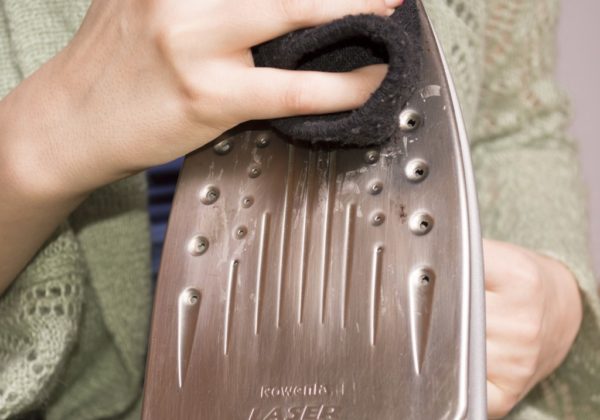
To clean Teflon and ceramics at home, you can apply and care for glass-ceramic cooking surfaces: Top House (Top House), Optima Plus, etc. They are available in the form of gels and creams that do not scratch naughty non-stick coatings. You can clean the iron from the burner on the sole with the help of a similar tool, following the instructions. After use, wipe the sole with a soft cloth.
If there are no cleaning chemicals, and the burnt iron needs to be cleaned urgently, then solvent for paints containing acetone or nail polish remover will help.When using these aggressive substances it is necessary to ensure that they do not fall on the plastic parts of the iron, since many types of plastic dissolve in acetone. The removal of soot can be done with a cloth dipped in solvent by rubbing a dark spot on the sole.
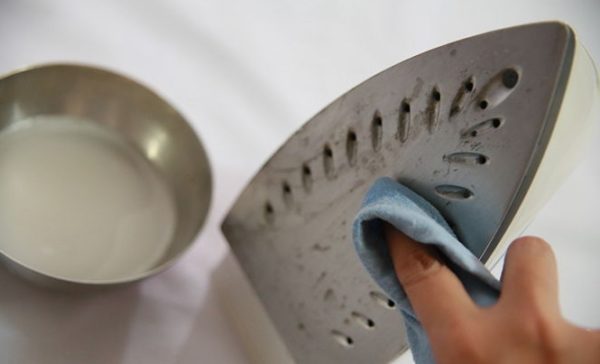
There are some more safe methods of removing plaque at home for Teflon and ceramic coatings:
- Preheat the iron and unplug it. Moisten a soft cloth or sponge in vinegar (6-9%) and wipe the surface, removing dirt. Holes for steam can be cleaned with cotton buds. This method eliminates not only carbon, but also scale from hard water.
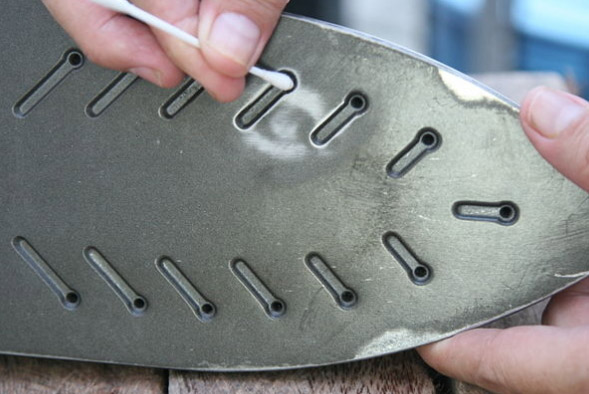
- Set the thermostat to maximum heat, turn on the device in the network. Moisten a piece of stiff cloth (towel, linen cloth) in 3% hydrogen peroxide, spread the cloth on a flat surface and iron it with a warm iron. The procedure can be repeated several times until the sole is completely clean.
- Liquid toilet soap, shower gel, applied to the slightly warm surface of a burnt iron, clean it no worse than a special product. Mass applied to contaminated soles and leave for 40 minutes.Wipe the surface with a clean cloth.
Means containing acids and acetone are harmless to Teflon or ceramic spraying, but they are completely unsuitable for metal soles on irons. Cleaning models with such surfaces is much more difficult.
How to clean a metal iron?
A polished steel or aluminum surface is not recommended to be cleaned with a stiff metal brush and scraper. You can not scratch such a sole with a knife and rub with sandpaper. However, there are no special problems in how to remove a deposit that is very firmly adhered to the metal. Unlike modern coatings, steel can tolerate stronger impacts.
The cleaning agent tested not by one generation of housewives - usual table salt. Sharp-edged crystals can damage the thin coating of Teflon or ceramics, but are unable to scratch the steel surface. This is used by experienced housewives in different versions:
- Moisten a handful of coarse salt with water, and sprinkle the crystals on thick paper or cardboard. Heat the iron to the maximum and hold it over the salt layer several times, pressing a little (as in ironing clothes). After the result is achieved, wipe the surface with a rag.
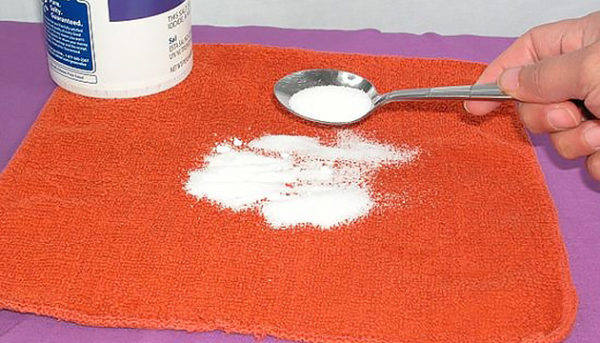
- Fold the gauze in half, pour salt into it and wrap the edges of the cloth. Moisten the prepared tampon, heat the iron slightly and clean it in a circular motion until the stain disappears.
- If the deposit has just formed and the layer of soot is minimal, then you can pour a pinch of fine salt on a warm work surface and wipe the iron with a damp rag.
Salt crystals can damage an aluminum sole, so for its cleaning it is best to use option 2 or use other means.
Not very heavy pollution can be removed with a white paraffin candle. To do this, it must be wrapped in a dense fabric of natural fibers (linen, cotton), heat the device and clean its surface. With this method, it is important to prevent paraffin from entering the steam holes. After the carbon has been removed from the iron, it is necessary to carefully remove paraffin residues: heat the device to the maximum, iron several times with a clean rag until no more traces remain. This method is also suitable for devices with an aluminum base.
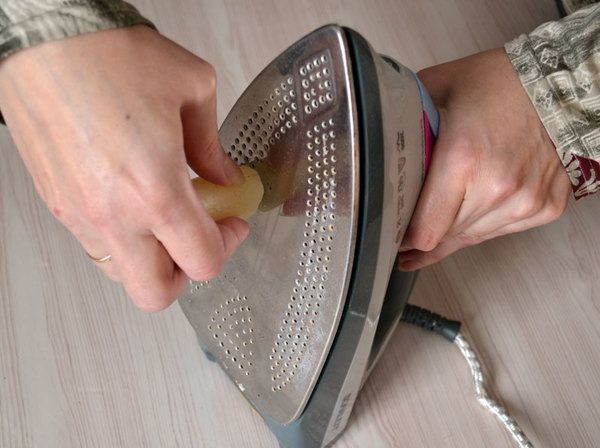
Well cleans the metal surface and sodium bicarbonate (soda). For cleaning, you can use a slurry of powder with water that needs to be applied to a cold iron.If the deposit is old and difficult to remove, the soda can be left for 20-30 minutes, after which it is possible to wipe the sole with polishing movements. Rinse off residues with a damp sponge.
How can you avoid soot
In order not to form a layer of burnt fabric fibers on the working surface of the iron, you can use special pads of thin metal. Some manufacturers of home appliances supply them with iron. About the availability of a suitable lining for a specific model, you can ask the consultant in the store that sells household appliances.
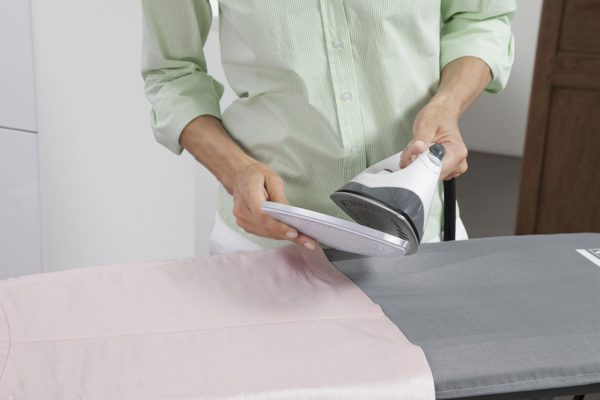
Replace such a lining, to maintain the perfect surface of the sole, to prevent damage to the printed pattern or appliqué on clothes, sticking paint can ordinary gauze or denser cotton fabric. This simple measure of protection will avoid the formation of shiny areas (Lasa) on woolen items and dark fabric during ironing.
In such cases, gauze is used in dry form. It is not necessary to moisten it as when steaming. Cotton fibers do not stick at the temperatures recommended for ironing synthetic and wool fabrics.Therefore, carbon does not form on the iron, and things remain intact even with a slight excess of the allowable heating.
It is possible to keep the working surface clean for a long time, observing the temperature regime, using simple measures to prevent the formation of soot. Rubbing it with a clean cloth each time after ironing will prevent the accumulation of dirt particles to which new fibers may stick. In that case, if it was not possible to avoid burning tissue, 1 of the proposed cleaning methods can help. It is only important to remember that the bloom, which occurred once, is much easier to clean than to clean a very dirty iron.

/rating_on.png)
/rating_off.png)












